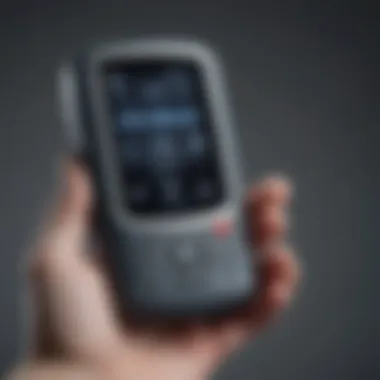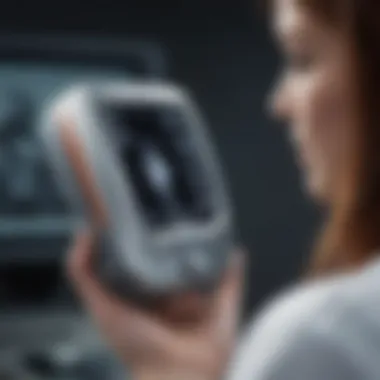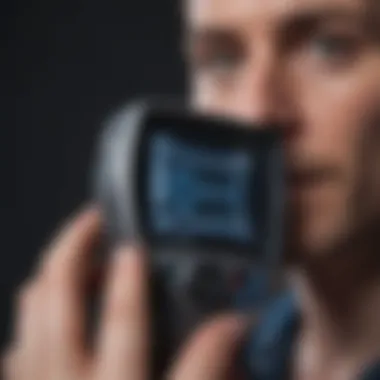Handheld Sonography: Transforming Medical Diagnostics


Intro
The landscape of medical diagnostics has undergone a remarkable transformation over the years. One of the technologies leading this wave of change is handheld sonography. Unlike traditional ultrasound machines that typically occupy a room in hospitals, handheld devices are compact and portable—fitting comfortably in a physician's bag or even pocket. This advancement is not just a matter of convenience; it represents a shift towards more accessible and immediate patient care.
The rise of handheld sonography stems from a series of technological advancements that have made imaging simpler, quicker, and more efficient. These devices allow healthcare professionals to perform ultrasounds at the point of care, enhancing their ability to make decisions right on the spot. Imagine a situation where a physician can provide accurate insights during a patient’s visit instead of sending them off to a radiology department. This kind of immediacy can be crucial, especially in emergency settings or rural areas where facilities may be limited.
In this article, we will explore the impact and applications of handheld sonography, emphasizing key findings that reveal its significance in the medical field. The narrative will also cover implications of this technology in real-world scenarios while discussing potential future research directions. Through a thorough examination, our aim is to paint a comprehensive picture of how handheld sonography is shaping modern healthcare practices.
Prologue to Handheld Sonography
Handheld sonography is not just another fancy gadget in the medical toolbox; it’s a game changer that has begun to pave the way for a new era in diagnostic imaging. This section aims to shed light on what handheld sonography really is and why it matters so much in today’s healthcare landscape. Armed with compact devices, healthcare providers are finding a wide array of applications in various settings, from bustling emergency rooms to remote clinics that lack access to standard imaging equipment.
One of the standout features of handheld sonography is its capacity to enhance accessibility. In regions where traditional ultrasound machines are impractical, these portable devices step in as a versatile alternative. They democratize the diagnostic process, transcending geographical barriers, and making quality care more attainable for all.
Definition and Overview
To grasp the full impact of handheld sonography, it's essential to first understand what it entails. Handheld sonography refers to ultrasound imaging conducted with compact, portable devices that can fit into a healthcare professional's palm. Unlike traditional ultrasound equipment that can take up a whole room, these handheld units offer remarkable flexibility and ease of use.
Patients benefit greatly from this convenience; diagnostic processes can be conducted right at the bedside or in a primary care environment, which reduces waiting times for results and enhances patient experiences. Furthermore, many of these devices connect wirelessly to smartphones or tablets, facilitating real-time image sharing among specialists for quicker consultations.
In short, handheld sonography is transforming the landscape of medical imaging, providing healthcare professionals with tools that blend advanced technology with unmatched portability.
Historical Context
The journey of sonography, let alone handheld devices, has its roots deep in medical history. The first ultrasound machine made its appearance back in the 1950s, conceived for evaluating fetal development in obstetrics. Fast forward to today, and portable ultrasound devices are replacing their bulky predecessors in many settings.
From the first rudimentary images to the high-definition results we see today, it's been a significant evolution of technology. Early attempts at handheld devices emerged in the late 20th century but often fell short of practicality due to limited imaging quality and functionality.
However, in the past decade, we've seen a surge in innovation. Advancements in technology have enabled manufacturers to squeeze the power of larger machines into pocket-sized versions without compromising the quality of images produced. This has not only brought ultrasound into the hands of practitioners but also significantly broadened its applications across varied medical disciplines.
As we continue to explore the influence and applications of handheld sonography throughout this article, it’s pivotal to appreciate the historical context that has led to its current significance.
Technological Advancements in Sonography
The significance of technological advancements in sonography cannot be overstated. As handheld sonography devices become more widely available, they are reshaping how medical professionals diagnose and treat patients. With improvements in design, functionality, and operational capabilities, these devices are not just tools—they are innovations that open up new possibilities within healthcare. In examining this topic, one can observe both the enhancements in diagnostic accuracy and the increased accessibility to medical imaging.
Key Features of Handheld Devices
Handheld sonography devices come packed with features that enhance both their usability and effectiveness compared to traditional ultrasound machines. First and foremost, portability stands out as a defining characteristic. Physicians can easily take these lightweight devices from room to room, or even outdoors in emergency situations. The convenience of having a diagnostic tool that fits in a pocket—think of it as akin to carrying a smartphone—enables immediate patient evaluation well away from a hospital setting.
Moreover, many of these handheld units are coupled with intuitive user interfaces, allowing medical professionals of varying skill levels to efficiently operate them. Touch screens, for instance, are common, providing a familiar interaction mode. Customizable settings enable doctors to adapt the screen display to their specific diagnostic needs.
Another essential feature is the integration of wireless connectivity. This capability allows for easy sharing of images and results. For example, a primary care doctor can instantly send obtained images to a radiologist for further review. This expedites the diagnostic process, leading to quicker treatment decisions.
"The reality is, in today's fast-paced medical environments, time is often of the essence. Handheld sonography devices not only save time but can also potentially save lives."
Improved Image Quality and Efficiency
Modern handheld sonography devices boast significant improvements in image quality—a critical factor in the effectiveness of ultrasound diagnostics. Enhanced imaging technology translates into clearer visuals with greater detail, allowing healthcare professionals to make more informed decisions.


These devices employ advanced algorithms to process images, which can help detect abnormalities with a level of precision that was previously limited to larger machines. For instance, studying anatomical structures or identifying conditions like organ abnormalities is now more feasible in real-time scenarios. This immediacy bolsters confidence in on-the-spot evaluations in emergency care situations.
Furthermore, faster processing speeds contribute to overall efficiency. The agility of these devices means that healthcare professionals can conduct scans and receive immediate feedback, which leads to more streamlined patient interactions. Less waiting time can directly correlate with reduced anxiety levels for patients—a crucial aspect in overall care.
The implications of these advancements are profound. Not only does improved image quality increase diagnostic accuracy, but it also enhances the entire patient experience, making healthcare more responsive and less intimidating.
In summary, technological advancements in sonography—especially handheld devices—reflect a shift toward a more modern, efficient, and patient-centered approach within medical practice. The key features and improvements in image quality and processing speed can ultimately reshape how care is delivered across various settings, from primary care clinics to remote locations.
Application Areas of Handheld Sonography
The world of medicine is broad, and handheld sonography is carving a niche that is both transformative and necessary. Its versatility allows it to be employed across various medical settings, improving diagnostics and patient care. By understanding its applications, healthcare professionals can fully appreciate the potential that handheld sonography presents in enhancing the quality of care. This section delves into three critical areas: primary care and emergency settings, obstetrics and gynecology, and pediatric applications, exploring the unique benefits and considerations within each domain.
Primary Care and Emergency Settings
In primary care and emergency rooms, time is of the essence. Handheld sonography acts as an invaluable tool, offering rapid diagnostics that can make a world of difference in patient outcomes. These devices enable healthcare providers to evaluate patients on the spot, minimizing the need for invasive procedures or unnecessary delays.
- Immediate Assessment: Imagine a patient coming in with abdominal pain. A doctor equipped with a handheld ultrasound can quickly check for gallstones or even signs of appendicitis. This immediate feedback allows for prompt treatment decisions.
- Accessibility: Not every healthcare facility boasts a full-sized ultrasound machine, especially in underserved areas. The compact size of handheld devices means they can be taken where they’re needed most, enhancing accessibility to care.
As nurses and doctors adapt to the rapid changes in technology, they may find that handheld sonography allows for better triage and prioritization, ultimately leading to improved patient experiences.
Obstetrics and Gynecology
In the field of obstetrics, the use of handheld sonography is a game changer. For expectant mothers, routine check-ups can often feel like a series of long waits and anxiety. With handheld sonography, the experience is more streamlined.
- Bedside Scanning: Imagine a doctor showing a moving image of the baby to a mother during a routine check-up. This immediacy not only helps in confirming healthy fetal development but also enhances the emotional connection between the patient and provider.
- Monitoring Complications: In cases where pregnancy is deemed high-risk, like gestational diabetes or placental issues, having the ability to perform quick evaluations can make all the difference. Physicians can monitor changes in real-time, tailoring their care plans to fit emerging needs.
Pediatric Applications
When it comes to pediatrics, one size does not fit all, especially in diagnostics. Young patients often succumb to stress and anxiety more than adults, making the use of handheld sonography especially beneficial.
- Non-Invasive Evaluations: Children are notoriously fearful of invasive procedures. The ability to assess conditions like appendicitis or hip dysplasia without unnecessary intervention is crucial. Handheld sonography does just that, giving healthcare providers a way to obtain clear images with less distress.
- Portability for Home Care: In some cases, pediatricians may need to visit a patient at home. The lightweight nature and portability of handheld devices facilitate this type of flexible care, allowing timely evaluations that could prevent critical delays in treatment.
"Handheld sonography makes diagnosing conditions in young children less daunting and more effective, showing us a future where diagnostic tools could be even more integrated into everyday healthcare."
In summary, handheld sonography is not merely a technological advancement; it significantly enhances clinical practice across various settings. The implications are clear: time-saving capabilities, improved accessibility, and increased engagement between practitioners and patients come together to foster a more efficient and compassionate healthcare experience.
Understanding these application areas presents a fascinating glimpse into the potential of this technology, encouraging further exploration in the upcoming sections of this article.
Advantages of Handheld Sonography
The benefits of handheld sonography stretch beyond mere convenience; these devices are fundamentally reshaping how diagnostics are approached in various medical settings. Their advantages can lead to more informed decisions, better patient outcomes, and broader access to essential healthcare services. Below are some key aspects that outline the significance of handheld sonography in modern medicine.
Portability and Accessibility
One of the primary strengths of handheld sonography is its portability. Unlike traditional machines, which often require dedicated space and considerable setup time, handheld devices can be carried around easily. Imagine a physician carrying a device in their bag, ready to perform an ultrasound on the spot. This capability is especially valuable in rural areas or emergency situations where traditional equipment might not be readily available.
The ease of transport means that patients can receive imaging right where they need it. In critical care scenarios, such immediacy can spell the difference between life and death. Moreover, the presence of the device at the point of care diminishes the need for patient transfers, reducing discomfort and wait times. So, when someone talks about accessibility, handheld sonography truly walks the walk.
Cost-Effectiveness
Cost is always a crucial factor in healthcare decision-making. Handheld sonography brings a new layer of financial sense into the picture. The initial investment for handheld devices often pales in comparison to large ultrasound machines, not to mention the ongoing costs associated with those bulky units, which might require specialized maintenance and extensive technical support.


Let’s break down some specifics regarding costs:
- Lower Purchase Prices: Many portable sonography devices are priced significantly lower than their traditional counterparts.
- Reduced Overhead: Facilities save on infrastructure and operational overhead since they can be moved easily, thus requiring less dedicated space.
- Decreased Patient Transfers: With on-site testing, hospitals minimize the costs associated with transporting patients to and from imaging suites.
In the grand scheme of things, the widespread use of handheld sonography could potentially lead to lower healthcare costs overall, making quality care more attainable for a larger segment of the population.
Enhanced Patient Interactions
The adoption of handheld sonography certainly influences not just the technical side of healthcare, but also significantly enhances the patient experience.
In traditional settings, discussing results can often feel like a game of telephone— where patients are shuffled between various personnel before they ever get the closure they need. With handheld devices, physicians can show real-time images to their patients, demystifying what might seem like a foreign process. This immediacy cultivates trust and transparency, crucial elements in a provider-patient relationship.
Think about it:
- Visual Engagement: Patients can see what's happening inside their bodies as it occurs, leading to better understanding and acceptance of medical findings.
- Informed Decision-Making: Immediate access to ultrasound images empowers doctors and patients alike to discuss treatment paths in a more meaningful way.
- Reduced Anxiety: Knowing what’s going on can alleviate patient worries, making visits to the clinic feel more like constructive conversations rather than daunting tasks.
"Handheld sonography doesn’t just bring images; it brings clarity in communication, enhancing the whole patient experience."
In summary, the advantages of handheld sonography reach far and wide, bringing portability, cost efficiency, and improved interactions into the fold. As we continue to navigate the intricate landscape of modern healthcare, the role of these devices will maintain its crucial importance.
Challenges and Limitations of Handheld Sonography
While the benefits of handheld sonography are significant, it's crucial to address the challenges and limitations that accompany this technological marvel. These aspects not only affect the utilization of handheld ultrasound devices but also impact patient care and healthcare delivery at large. By understanding these challenges, healthcare professionals can mitigate potential drawbacks and make informed decisions about how to best integrate handheld sonography into their practices.
Training and Skill Requirements
One of the most pressing challenges associated with handheld sonography is the necessity for adequate training and skill development. Unlike traditional ultrasound systems, which often require specialized education for technicians and sonographers, handheld devices may appear deceptively simple to use. However, this simplicity can lead to a false sense of security. Operating these devices effectively demands a solid grasp of ultrasound physics, anatomy, and optimal imaging techniques.
Healthcare practitioners, particularly in primary care and emergency settings, must undergo thorough training before they can confidently interpret ultrasound images.
"Proper training not only enhances diagnostic accuracy but also ensures patient safety."
Without a foundational understanding, there’s a risk of poor diagnostic quality and misinterpretation of images. It becomes evident that training shouldn't just be about user familiarity with the device but should also encompass critical thinking skills, enabling practitioners to correlate clinical findings with ultrasound results.
Technical Limitations
Another important consideration is the technical limitations inherent in handheld sonography. While these devices boast significant advancements, there are still constraints compared to traditional ultrasound machines.
- Image Resolution: Handheld devices often have lower image resolution than larger, stationary machines. This difference can affect the ability to visualize fine details, which is crucial for accurate diagnoses.
- Limited Modalities: Most handheld sonography systems focus on a specific set of functionalities, like obstetric and cardiac assessments, with limited capability for advanced imaging techniques such as Doppler studies. As a result, some critical diagnostic applications may be out of reach.
- Battery Life and Performance: The portability of these devices comes with the price of reduced operational performance. Battery life can be a limiting factor in emergency settings, where extended use may be necessary.
- Standardization: There is a lack of standardization among handheld devices. The variation in performance and image quality between different manufacturers can create inconsistencies in clinical practice, making it difficult for practitioners to rely on one model over another.
Understanding these challenges not only sets realistic expectations for healthcare providers but also opens the door for continued innovation and improvement in handheld ultrasonic technology. Despite these hurdles, the potential for impacting patient care remains strong as ongoing developments address many of these limitations.
Impact on Healthcare Delivery
The integration of handheld sonography in modern healthcare systems has brought about significant shifts in how medical professionals diagnose and treat patients. This technology is not just a novel gadget; it's a game-changer in terms of accessibility, immediacy, and accuracy of medical evaluations. Handheld devices serve as a bridge between traditional sonography and point-of-care ultrasound, bringing high-quality imaging directly to the patient's bedside or even remote locations.
Improving Diagnostic Accuracy
In a field where precision can make or break patient outcomes, handheld sonography enhances diagnostic accuracy substantially. Traditional imaging methods often require lengthy appointment schedules and costly equipment, making timely diagnosis a serious hurdle. However, with handheld sonography, doctors can perform scans quickly and efficiently, enabling them to identify abnormalities during a patient visit rather than waiting days for results.


For instance, in emergency departments, quick assessments can be the difference between life and death. A study revealed that handheld ultrasound devices detect free fluid or hematomas in trauma patients with up to 90% accuracy. This immediacy helps clinicians make better-informed decisions regarding treatment and interventions.
Additionally, the portability of these devices lets healthcare providers conduct examinations in various settings, from remote clinics to disaster zones, ensuring that care reaches those who need it most.
Facilitating Remote Consultations
As telemedicine gains momentum, handheld sonography plays a pivotal role in its evolution. The ability to perform diagnostic imaging remotely allows healthcare practitioners to maintain high-quality care, even when patients cannot visit a clinic or hospital.
Imagine a situation where a rural patient has symptoms related to an abdominal issue. Instead of making a long trip, the patient can have a handheld ultrasound conducted right where they are, with results simultaneously sent to a specialist in a different city for review. This not only saves time but also alleviates some of the healthcare disparities that exist in underserved areas.
In addition, tele-sonography has emerged, enabling real-time data sharing between practitioners. The specialist can guide the primary care provider on what to look for, enhancing diagnostic processes even further.
"Handheld sonography breaks geographical barriers, bringing equitable healthcare access to even the remotest locations."
Through these advancements, handheld sonography not only improves the efficiency of consultations but also builds a framework for a healthcare system that increasingly prioritizes convenience and quality of care.
In summary, the impact of handheld sonography on healthcare delivery is profound, reshaping how diagnostics are approached and integrated within various medical disciplines. It ultimately leads to better patient outcomes, satisfies the ever-growing demand for healthcare accessibility, and prepares the healthcare industry for future challenges.
Future Prospects of Handheld Sonography
The future of handheld sonography beckons with promise, urging us to look beyond its current capabilities. This technology is revealing pathways where innovative concepts can transform not only diagnostics but also overall patient care. Understanding these prospects is crucial for all stakeholders in the healthcare field, from students to seasoned professionals.
Integrating Artificial Intelligence
Artificial Intelligence (AI) stands out as a game-changer in the realm of handheld sonography. The integration of AI can facilitate improved image interpretation and diagnostics at a previously unimaginable speed. Practitioners often spend a considerable amount of time analyzing an ultrasound image; AI can assist, offering suggestions and flagging anomalies.
- Enhanced Accuracy: By utilizing vast datasets, AI can recognize patterns that may be challenging for human eyes to discern. These intelligent systems continuously learn and adapt based on new data, leading to remarkable improvements over time.
- Real-Time Analytics: With the incorporation of AI algorithms, healthcare providers can obtain instant insights while conducting the examinations. This capability helps in making quick decisions, especially in emergency settings.
- Workflow Efficiency: AI can reduce the workload on healthcare workers by automating routine tasks, freeing professionals to focus on more complex diagnostic challenges.
Nonetheless, the integration of AI must be approached with caution.
"The marriage of technology and healthcare is not without its challenges; it requires thoughtful consideration and robust testing."
It’s imperative to ensure that AI systems are reliable and ethical, particularly because they can impact patient outcomes significantly. Rigorous testing protocols should be established to validate systems before widespread adoption.
Expanding Applications to Emerging Fields
While predominantly used in traditional areas like obstetrics and emergency medicine, there is a growing recognition of handheld sonography's potential in emerging fields. Areas such as telemedicine, veterinary care, and even nutrition are starting to see the introduction of handheld ultrasound technology.
- Telemedicine: Handheld devices can bridge the geographical gap, allowing remote areas access to ultrasound services. Imagine a healthcare practitioner in a rural setting using a handheld device to consult with specialists in urban centers.
- Veterinary Medicine: Veterinarians can use handheld sonography to assess animal health efficiently. This application not only aids in diagnosing conditions but also enhances the overall welfare of animals through timely interventions.
- Nutritional Assessment: Some researchers are exploring the use of ultrasound in dietary sciences, particularly how it could assess fat distribution or muscle mass in populations striving for wellness.
Finale
The conclusion of this article crystallizes the essence of handheld sonography and its ever-growing significance in the healthcare landscape. In an age where quick diagnostic capabilities can make or break patient outcomes, handheld sonography stands as a beacon of progress. It bridges the gap between traditional diagnostic methods and innovative, mobile technology, offering numerous benefits that resonate deeply with both patients and medical professionals.
Summarizing the State of Handheld Sonography
Handheld sonography has transformed from a niche tool to an essential part of clinical practice. Its portable nature allows practitioners to conduct scans at the point of care, making it a vital resource in emergency rooms, outpatient settings, and remote locations. No longer confined to imaging departments, these devices place diagnostic capabilities directly into the hands of healthcare providers, enhancing patient management and streamlining workflows.
This technology not only increases the accessibility of ultrasound imaging but also significantly improves the quality of care delivered. With advancements in image quality and real-time analysis, providers can make more informed decisions swiftly. The affordability of these devices has also increased their reach, empowering even small clinics to incorporate sonography into their practice.
Furthermore, data suggests that the integration of handheld devices leads to improved patient interactions. Patients can see their scans in real-time, fostering greater understanding and engagement in their health. This is particularly beneficial in pediatric settings where visual aids can alleviate anxiety and enhance communication with young patients. In summation, the current state of handheld sonography is a testament to its dynamic role in modern medicine, capable of enhancing both patient experience and clinical effectiveness.
Call for Ongoing Research and Development
Even with all the progress made, the journey does not end here. There remains a strong need for ongoing research and development in the field of handheld sonography. Future advancements could focus on expanding functionalities such as multi-modal imaging, improved algorithms for automated analysis, and enhanced connectivity to electronic medical records. This integration could streamline workflows further and allow for more effective remote consultations.
Additionally, as technology continues to evolve, it is crucial to address the challenges and limitations discussed earlier. Training for healthcare providers needs to keep pace with advancements in technology to ensure proficiency and accuracy in diagnosis.
Moreover, collaborative research initiatives between manufacturers, academic institutions, and healthcare facilities can drive innovation. Engaging in clinical trials and evaluating long-term outcomes will solidify the role of handheld sonography within diverse medical specialties.







